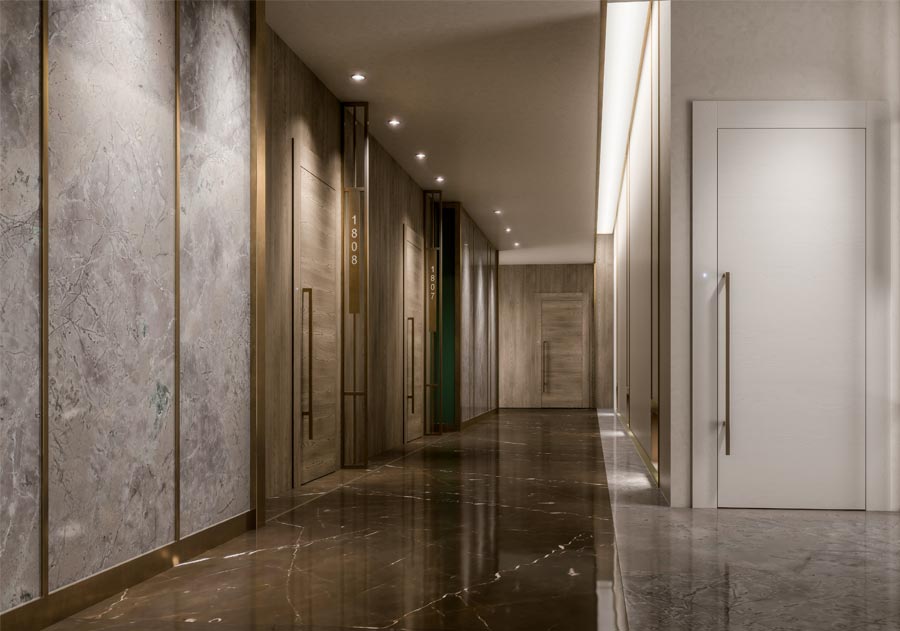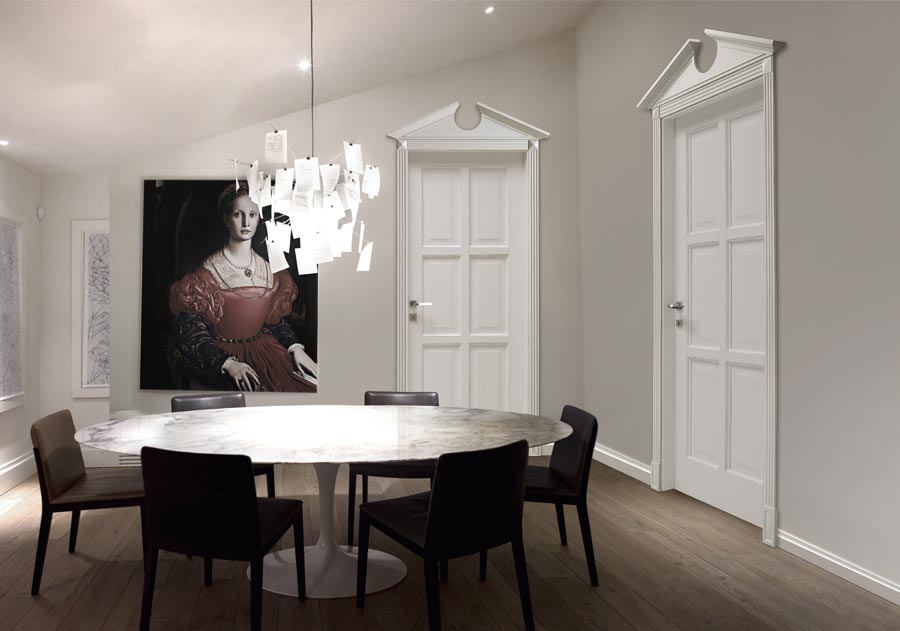| MAGAZINE
How to match doors and floors

In a renovation, be it an apartment, an office or a commercial space, all too often we end up prioritizing certain choices and wasting energy when it comes to defining the final aspects, such as matching doors and floors, for example, or what kind of light fixtures to buy.
There are so many choices at stake that, at times, it becomes difficult to ensure the cohesiveness of all the elements.
Yet in terms of quality, it is the consistency of the whole that makes the real difference.
Doors
for example
Consider doors, for example: how often do people choose to resort to the classic white door, favoring, rather, the choice of flooring?
The reality is that matching the doors with the floor itself gives the entire room an elegance that reflects greatly on the overall image quality.
And even if we were to consider the choice of material to lay on the floor – the type, color and finish – as a priority, thanks to the very wide range of interior doors on the market (which, with “custom” production, loses all limits), excellent design results can always be achieved nowadays.
Getting into specifics, how do you match doors and floors in the correct way? Is there a right way?

The Choice
First, the choice of a door can be made on two different levels: type and finish.
In terms of typology, distribution design and room layout often “dictate”.
Hinged or sliding door, inside or outside the wall, glazed door, flush with the wall, space-saving (rototranslating), one, two or more leaves: in most cases, the choice is dictated by the design of the space.
Except for glazed doors and flush doors (which, of course, follow the wall), far wider are the margins of movement in orientation on the various finishes.
This is where a world of ideas opens up and the “problems” begin, as is the case whenever one is faced with a choice in an overly broad range of solutions.

Therefore, before moving on to suggesting possible pairings and going into the specifics of materials and colors – light or dark doors, wood effect, gray doors, neutral, classic or designer doors, etc. – it is necessary to focus attention on one fundamental aspect: the criterion of choice.
Project vision
One of the most common mistakes in design is to immediately aim for the single detail without having a clear bigger picture.
Tons of projects claim to solve functional and distributional problems or improve the image of an environment without having asked the question: what is the basic idea behind the project? What do I mean by that? What’s my point?
Basically, what is the vision that characterizes the redevelopment of spaces that I am addressing?
If, for example, it is an apartment, on the scale is the taste of the people who are going to live there, the style that corresponds to their personalities, the colors that will most successfully translate their sense of well-being.
For a hotel, the concept will be the soul that the business owner wants to convey to the guest. For a commercial venue, the idea will match the brand message to the customer.
In each case, it is the vision, posed at the basis of everything, that provides the criterion by which the choice of how to match doors and floors (but also the color or furniture to be chosen consistently) proves right or wrong.
There is no such thing as a right choice or a wrong choice if you do not first ask yourself the question about the result you want to achieve. Therefore, we are wary of any preordained solution no matter what – they are more convenient but do not necessarily lead to the desired result.

Contrast
or continuity?
Take the case of a dark toned floor, whether it is a parquet, porcelain stoneware or wood-effect vinyl floor.
We may use a light-colored door if we want to create a contrast, in line with a more modern vision, according to which, presumably, we will also have used light colors on the wall, also contrasting with the floor.
Contemporary style may push us toward a totally unconventional door surface design, perhaps with linear or oblique cuts or a grain pattern (in the case of wood finish) that goes beyond the traditional rules of classic doors.

Even adopting a more “Parisian” style, typical of apartments in the Ville Lumière, doors will be light-colored, mainly white, contrasting with the dark (often very dark) floor, but will feature frames, moldings and mirrors.
By virtue of a more classic concept, however, we could choose a dark door, in continuity with the tone of the floor. Again, referring to the overall vision, the walls will have darker shades, without necessarily creating a monochrome effect over the entire room.
What’s your
style?
So rather than “how do I match doors and floors”, the question to ask is: what style do we want to give to the rooms we are decorating?
Between classical and modern styles we find shades of all kinds. The following is an overview – not an exhaustive one – that can be a guideline to assist you in your choice.
Shabby Chic:
light or bleached floors, classic door, possibly white with mirrors, glazed or unglazed.
Scandinavian:
again, the tones are very light, but the rooms are not necessarily white. Indeed, for walls, colors can take on interesting, non-full color shades, such as sage green or powder blue. In this case, the doors could be white but not weighed down by a thousand frames.
Rustic:
here the tones become heavier and the woods of floors and doors, in desirable continuity of appearance, both tend to have a predominance of yellows, in combination with white or warm-colored walls.

Industrial Style:
characterized by gray or neutral tones. With a gray floor (stoneware, but also resin) the match could be with light-colored doors or “grayed-out” wood finishes, meaning color that is not too full, not too yellow, and not too red.
Of course, where possible, a glazed door with a black frame would be perfect…
Trends
We could go much further, even to the point of studying market trends, should we wish to opt for a future style. And the market today talks a lot about color.
What about a colorful lacquered door? Here it becomes the protagonist of the space, paired with a stoneware with a contemporary, geometric effect or with neutral colors to enhance those of the doors and walls.

Beware, however: while leaving the doors open to a thousand different solutions depending on the design vision, there are mistakes that should always be avoided if possible, because the resulting outcome would not be the best.
These include, for example, seeking continuity between parquet or wood-effect flooring and the door by bringing two materials that are similar but not the same (grain, color, etc.) closer together: in this case, it is better to break away with a sharp contrast.
A final hint on aspects apart from floors, colors and finishes: when choosing doors, never disregard the quality of materials: that precision and efficiency are always guaranteed so that the creative result is enhanced by the best attention to detail.
| GET IN TOUCH
For more information, please fill in the form.

